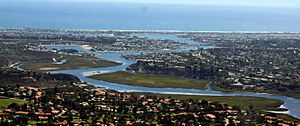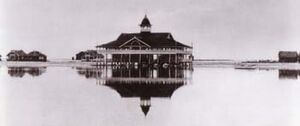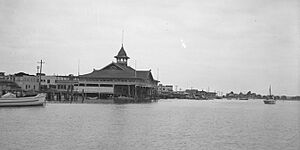History of Newport Beach, California facts for kids
The history of Newport Beach, California began long ago, even before Europeans arrived. For thousands of years, Native American groups like the Tongva and Juaneño/Luiseño people lived in this area.
European explorers first mapped the coastline in the 1500s. Juan Rodríguez Cabrillo sailed along the coast in 1542. But it took about 200 years for Europeans to actually settle here. In 1769, the Newport area became part of a huge land grant given to Don José Antonio Yorba I. This was first under Spanish rule, then Mexican rule.
After the Civil War, American settlers started developing the land. James Irvine focused on ranching, while James McFadden worked on shipping. A small town grew around McFadden's Wharf, which is where the Newport Pier is today. This wharf became the biggest business in Orange County. However, when the San Pedro Harbor opened in Los Angeles in 1899, commercial shipping in Newport slowed down. Newport Beach then became a popular place for tourists and for boating. In August 1906, Newport Beach officially became a city.
Contents
Early Days of Newport Beach
For thousands of years, the Tongva and Juaneño/Luiseño people nations lived in this area. In 1542, Juan Rodríguez Cabrillo explored the coast of California for Spain. Later, in 1602, Sebastián Vizcaíno also mapped the coast for the Spanish Empire.
One important early Spanish colonizer was Jose Antonio Yorba (1746–1825). He came to California in 1769 as an officer. For his service, the Spanish Empire gave Yorba a huge land grant in 1801. This grant covered a big part of what is now Orange County in Southern California. It included the lands where cities like Orange, Santa Ana, and Newport Beach are located today.
During the Spanish period, large ranches (called Ranchos) traded animal hides with merchants from the United States and Europe. This trade continued when Mexico took over California from Spain in 1821. Many new settlers were offered land if they became Mexican citizens and converted to Catholicism. Some American immigrants even married into Spanish families and became known as Californios, gaining land and ranches.
Mexican Ranchos and Big Land Deals
When Mexico became independent from Spain in 1821, the time when missions controlled most of the land ended. The Yorba family kept their large land grant. Other land became available. By 1837, Jose Sepulveda, who was 35, received a huge piece of land. Five years later, he got even more land. Together, his lands covered almost 47,000 acres. This included areas north to the Santa Ana Mountains and south to Laguna Beach. However, it was later found that his grant did not include the land around Newport Bay or the oceanfront. These areas were thought to be worthless at the time.
Like most California ranches, Sepulveda's Rancho San Joaquin produced most of what it needed. They grew crops and raised cattle. Sepulveda focused on his grasslands and didn't pay much attention to the ocean nearby. He probably never even went near the water.
Sepulveda lived like a rich ranch owner. He claimed to have 3,000 horses and 14,000 cattle. He loved to host big family gatherings on his ranch. He was also a big gambler. Legend says he once won $25,000, 1,000 horses, 500 heifers, and 500 sheep in one race! He became even richer during the Gold Rush of 1849. Many hungry gold prospectors needed food, and his cattle were in high demand. He made money by driving his cattle all the way to San Francisco.
In 1852, after the United States took over California, a new law required ranch owners to prove they owned their land. This meant expensive surveys and court visits. Sepulveda's fancy lifestyle left him without enough money. A terrible three-year drought made his problems worse, killing many of his animals. Because of his debts and the loss of his herd, Sepulveda sold his ranch in 1864. This sale marked the start of the long-lasting Irvine era in the region.
Newport's Beginnings
After the ranches were sold, some business people came to the Newport area. Two of them, James Irvine and James McFadden, had very different ideas for Newport's future. Irvine loved the land and wanted to make money by owning a lot of ranch land. McFadden, however, wanted to create a town. He planned to divide his land and sell it to as many people as possible. He believed that more settlers would help Newport become an important business center. He was Newport's first big promoter.
James Irvine was born in Ireland. He came to New York in 1846 and then moved west. He worked as a miner and a merchant. He soon became successful enough to partner with others to start a wool business. When they had enough money, they bought Sepulveda's ranch. They also bought the Yorba family's ranch when it was sold. Soon, they owned over 100,000 acres, becoming the biggest landowners in the region. Irvine and his family focused on ranching. Their Irvine Ranch became a huge part of how Newport Beach grew over time.
James McFadden, from a family of Scottish ranchers, came to California in 1868. He quickly saw the potential of the Newport area. His brother, Robert, joined him. They started buying as much land as they could and dividing it to sell to buyers. After the Civil War, many more settlers came to California. While most looked for good farming land, some came to Newport. This led to the birth of a small settlement.
The people in this new settlement needed building materials and food. They were very excited when Captain Samuel Sumner Dunnels carefully sailed his steamer, the Vaquero, into the mostly unexplored Newport Bay on September 10, 1870. The boat was loaded with shingles and lumber from San Diego. He entered the bay slowly and successfully. This meant Newporters finally had a way to get needed supplies. Soon, Dunnels built a small wharf and warehouse near where the Newport Bay Bridge is today.
In its early years, Newport had many names. Most people believe the name "Newport" came from one of two ideas:
- Some say Captain Dunnels excitedly declared he had found a "new port" when he entered the bay.
- Others think an employee of the Irvine Ranch suggested it during a meeting about trade on the bay.
In 1875, James McFadden and his younger brother Robert bought the landing. For the next 19 years, they ran a successful shipping business. However, the bay wasn't a true harbor yet. Sand bars and a dangerous bay entrance made the McFadden Brothers move their shipping business to the oceanfront. They built a large pier on the sandy land that would become the Balboa Peninsula. This spot was perfect because a deep underwater canyon, carved by the ancient Santa Ana River, made the water calm near the shore.
In 1888, the McFaddens decided their shipping business would do better if they moved it from inside the bay to the oceanfront. This new location was connected by train to Santa Ana. So, they built McFaddens’ Wharf where the Newport Pier is today. McFadden Wharf quickly became the biggest business in the newly formed Orange County. For eight years, the McFadden Wharf area was a busy center for trade and shipping. A company town started to grow there. However, in 1899, the U.S. government decided to spend money on big improvements to a new harbor in San Pedro. This new harbor would become Southern California's main seaport. The McFadden Wharf and its railroad were sold that same year. This marked the end of Newport Bay as a major shipping center.
Newport Becomes a Resort Town
In 1902, James McFadden sold his Newport townsite and about half of the Peninsula to William S. Collins. Collins saw that Newport Bay had great potential as a resort and recreation area. Collins partnered with Henry E. Huntington in the Newport Beach Company. Huntington owned the Pacific Electric railway system. He used his railway to help new communities outside of Los Angeles grow.
In 1905, the Pacific Electric “Red Cars” (trolleys) were extended to Newport. Collins began digging a channel on the north side of the bay. He used the sand and dirt to build up the tidelands that would become Balboa Island. This charming little island, once called Balisle, wasn't always easy to reach. Newport Harbor was still mostly undredged, meaning it wasn't deep enough in many places. Sailboats were often the only way to get around. Robert McFadden, an early developer of Balboa Harbor, had already built a successful fishing wharf on the Balboa Peninsula.
In 1906, the Pacific Electric Red Cars started service to the Balboa Peninsula and Pavilion. Soon, these Red Cars brought thousands of summer visitors from Los Angeles.
Also in 1906, the Balboa Pavilion was finished, along with the Balboa Pier. These projects were built to attract people to buy land on the Balboa Peninsula part of Newport. Back then, houses on the bayfront sold for as little as $500.
With the arrival of the Pacific Electric Railway in 1906, Newport Beach truly became a tourist spot. The railway line ended at the Balboa Pavilion. In August 1906, Newport Beach officially became an incorporated city.
In 1908, John Scarpa, an Italian gondola operator, started the first Christmas lights boat parade in Newport Harbor. This began a long, yearly tradition that continues today.
In 1908 and 1909, William Collins moved his small dredge to the eastern part of Newport Bay. This area was a muddy flat called "Snipe Island." He started digging a channel along the north side of the bay, across from the Pavilion. He piled the sand and dirt onto the mud flat, and that's how Balboa Island was created. Balboa Island became a popular summer vacation spot. Most homes didn't have heaters and were closed in the winter. Families would come for the whole summer. Cooking was done on gasoline stoves because there was no gas or electricity. People used coal oil lanterns and candles for light.
In 1909, the first "seawall," a wooden barrier that protected part of the island, was built.
In 1910, the McFaddens sold Newport, Lido, and Balboa Island for $35,000.
In 1912, the seawall was partly replaced with a cement barrier.
In 1914, water lines were first laid to Balboa Island.
In 1916, Balboa Island officially became part of the city of Newport Beach.
In 1919, the island got its water from a famous "Wooden Water Tower" built on Agate Street. This tower was removed in 1929.
In 1920, Park Avenue was the only paved road on the island. People used outhouses behind their homes because there was no sewer system. They buried trash in big holes dug in empty lots. Also in 1920, gas service came to the island for heating, cooking, and lights.
In 1919, Joseph Beek, a college student, loved the area and became one of Collins' salesmen. Joe Beek played a very important role in developing Balboa Island. He spent his life dedicated to it. Beek got the first contract for a ferry service between the island and Balboa Peninsula.
In 1920, the first car was pushed across the bay on the ferry for 10 cents. In 1922, Joe Beek got a 15-year agreement to run the ferry, using the boat Joker, which could carry two cars. That ferry service has continued to this day, now with three 64-foot boats that can carry three cars each.
In 1922, the seawall was rebuilt.
In 1923, the city added Corona del Mar to Newport Beach.
In 1926, the Pacific Coast Highway was built through the city. A bridge over the Upper Bay was also built.
In 1929, the wooden bulkhead and walkway along the Grand Canal were rebuilt with concrete.
In 1936, Newport Harbor was officially opened. This happened after a $1.8 million project that dredged out the sandbars and extended the jetties.
In 1938, James Cagney, a famous Hollywood actor, bought Collins Island. The US Coast Guard used this island during World War II. Cagney eventually sold the island in 1948.
Later in the 20th century, Newport Beach became home to many famous people. The most well-known Newport Beach celebrity was John Wayne, also called “the Duke.” Orange County later named its airport after him. Other celebrities who lived in or kept boats in Newport Beach included Humphrey Bogart, Shirley Temple, and Errol Flynn. Also, "Roy Rogers and Dale Evans" and George Burns lived in Newport Beach. Other famous people included TV star Buddy Ebsen and Johnny Carson’s frequent guest host, Joey Bishop. Arizona Senator Barry Goldwater spent many summers at the Balboa Bay Club.
Newport Beach also became a center for tennis stars, especially from Australia. Australian professional players Rod Laver, Roy Emerson, Syd Ball, and Phil Dent all lived in Newport Beach at different times in their careers. This then led to a new generation of tennis stars from Newport Beach, like Taylor Dent, Carsten Ball, and Antony Emerson.
In 1953, the Boy Scouts of America held their third international jamboree (a large gathering) where Newport Center and Fashion Island are now. It was the first jamboree held west of the Mississippi River. 50,000 scouts from all 48 states, Alaska, Hawaii, and 16 other countries attended. Thousands of tents were set up in an area that could only be reached by a muddy, two-lane road called Palisades Road. The road was soon paved, and later its name was changed to Jamboree Road to honor the Scouts.
In 1955, the Newport Harbor Buffalo Ranch opened. This tourist attraction had a herd of buffalo and other exhibits about 'cowboys and Indians' from the 1950s. The attraction was notable for having several Native Americans on its staff, including one of Geronimo's grandchildren, Chief Cuthle Geronimo III.
In 1963, the first part of Eastbluff opened. This was the first "community" developed under the Irvine Company's big plan for the area.
In 1967, Fashion Island was completed. Newport Center Drive, a circular road, surrounds Fashion Island and gives it the "island" name. Newport Center's first office building was also finished that same year.
In 1969, the Irvine Company's twin towers were completed at Newport Center.
In 1971, Harbor View Hills, the second Irvine Company village in Newport Beach, opened. It includes the area between MacArthur, Ford, and San Miguel roads, and the area now called Spyglass Hill. The Big Canyon Golf Club also opened that year. The first of three eight-story glass towers for the Newport Medical Complex was completed.
In 1972, architect William Pereira's famous "flying saucer" building was completed at Newport Center. Also, Skidmore, Owings and Merrill's 18-story high-rise, which was the city's tallest building at the time, was finished.
In 1973, the private community of Big Canyon opened. This area was originally planned to be a landfill. Newport Beach real estate broker Marion Buie was an early supporter of developing it.
In 1990, construction began on Newport Coast.
|





